Fabulous Fiction Firsts #621: Spotlight on Women's Fiction Debuts

Nine Women, One Dress by Jane L. Rosen. This LBD, darling of the season (picked no less by WWD) is 90-year-old Morris Siegel's swan song, capping a long career as the celebrated pattern-maker for the Max Hammer line. But before he can truly retire, his LBD will touch 9 women's lives in unexpected ways.
From a Bloomingdale’s salesgirl dumped for a socialite to a secretary secretly in love with her widowed boss. From a young model fresh from rural Alabama to the jaded private detective who might have a chance to restore her faith in true love. From an unemployed Brown grad faking a fabulous life on social media to a mean girl who would die for the dress. Their encounter with the dress will transform them in ways beyond their imagination.
"Rosen’s debut novel is rich in relationships, written with clarity and humor and surprise twists that bring the tale to a satisfying conclusion." (Kirkus Reviews). Charming and irresistible, Chick lit at its best.
Review: U of M's “First Crop” Chamber Jazz Ensembles Concert

Jazz always seems to be the music that surprises me the most, with its playful syncopation, the clashes created by a few extra notes added to familiar chords, and the sheer ingenuity that comes from improvisation. On Sunday, I had the chance to be surprised by students in the chamber-jazz ensembles from the University of Michigan’s SMTD Jazz department, playing their own compositions and standards, and I came away with that warm-and-fuzzy feeling of having seen something enjoyable and unique. Hosted in the beautiful Stamps Auditorium on North Campus, it was a great space for the music, and the casual atmosphere was incredibly welcoming. The performers were still warming up on stage when I walked through the door — a serendipitous experience for myself and the others who decided to show up a bit early.
Fabulous Fiction Firsts #620

"There is only one day left, always starting over: it is given to us at dawn and taken away from us at dusk.” -Jean-Paul Sartre
In the tradition of great novels set in a single day, The Heart of Henry Quantum * follows an unhappily married 40-something SF advertising executive on December 23rd, as he wanders the city in search of a last-minute Christmas gift for his wife, Margaret.
Actually, it is not his heart (not immediately anyway) that the readers have to contend with, it is his mind - one that wanders. During a constant monologue, we learn about his youthful ambition (PhD, Philosophy), his marriage to Margaret, things he sees during the day, ideas that had come to him by chance. But much like Henry’s ever-wandering mind, his quest takes him in different and unexpected directions, including running into Daisy, his former lover, who made it clear during their impromptu lunch that she has never gotten over Henry.
Lest we feel sorry for Margaret, a high-power real estate broker... while Henry is wondering if Daisy might be the one who got away, she is heading out of the city on her own errand of the heart. Then we hear from Daisy, and finally Henry again as night falls. It will be a day of reflection, new choices, and change for all involved.
"With quick, witty dialogue and an expertly crafted stream-of-consciousness style, The Heart of Henry Quantum is a highly entertaining read that will remind readers of the power of one day to change a life." -Booklist
Writing for the first time as Pepper Harding, it is the pen name of a San Francisco writer currently living in Sonoma County. Highly recommended for book groups. Independent readers too, might find the thoughtful questions in the Reading Group Guide illuminating.
* = starred review
Review: Colm Tóibín at UMMA's Helmut Stern Auditorium

I’m tempted to say that it was standing room only at bestselling Irish author Colm Tóibín’s Thursday night reading – part of U-M’s Zell Visiting Writers Series – at UMMA’s Helmut Stern Auditorium.
But that seems not quite accurate, since many attendees who didn’t arrive in time to grab one of the venue’s 185 seats instead settled themselves on the floor of both side aisles, as well as the back wall.
Yes, the place was packed, but those who carved out a space for themselves got to hear Tóibín read from his novels Brooklyn and Nora Webster while also offering additional commentary and information.
While reading sections from Brooklyn – the basis for a film that earned three major Oscar nominations (including best picture) in 2016 – Tóibín noted, “One of the interesting things is that, the earliest recordings we have of Irish traditional music mainly come from America. The best players, best fiddlers, best singers, best accordion players all came from the West of Ireland, which of course is the poorest part of the country. There were no recording studios, so they went to New York or Chicago, and people rented them recording studios by the hour.”
Many of these Irish musicians would work as manual laborers, too, so they often had a foot in two different worlds. Tóibín cited Joe Heaney specifically, calling him the greatest singer of his generation in Ireland.
“There’s a photo of him in a pub in Dublin, where tradition music is played,” said Tóibín. “There were these Americans from New York who were visiting Dublin and saw the photograph on the wall of this pub, and they said, ‘That’s our doorman, Joe!’ Yeah, that’s our singer, Joe.”
Regarding Nora Webster, Tóibín talked about how he’d abandoned it to work on Brooklyn, and why he struggled with it so.
“Part of the problem was, so much of the book Nora Webster comes from memory, and that memory … has no shape until you shape it,” said Tóibín. “And therefore, [I was always trying to think, ‘What’s this thing or that thing that happened? Would it be interesting in a book, or just interesting to me, for reasons of my own? What should I leave out? What should I put in? What scene will work dramatically, and what won’t? It took much longer than writing a novel … where you imagine somebody else, some other life, some set of rules and specific experiences that I hadn’t witnessed.”
One other problem was that the atmosphere of the novel felt more like the 50s than the 60s, so he finally stumbled upon a subtle but time-specific way to root Nora Webster in its appropriate era.
“Some year around this time, I think ’67 or ’68 or ’69, hair dye arrived in town,” said Tóibín. “And you’d call to a friend’s house, and his mother would come to the door, and it was like autumn had come to the door. Her hair would have gone copper color. … And every woman in the town, to a one, fell to this. it was an amazing episode, really.”
Jenn McKee is a former staff arts reporter for The Ann Arbor News, where she primarily covered theater and film events, and also wrote general features and occasional articles on books and music.
Fabulous Fiction Firsts #619: Spotlight on UK Mystery Debuts

Referencing the New Testament parable, The Trouble with Goats and Sheep * by Joanna Cannon is set during the scorching summer of 1976 when 10 year-olds Grace and Tilly take it upon themselves to look for their neighbor, friendly Mrs. Creasy who disappears without a trace.
As the girls go door to door in search of clues (and God), the neighborhood starts to give up its secrets. "In a masterfully constructed plot, Grace—who sniffs out the lies told by her adult neighbors—learns a lesson about loyalty and true friendship, as secrets born of shame are gradually revealed. This understated, somewhat quirky debut novel is remarkable for its structure, characterizations, pitch-perfect prose, touches of humor, and humanity. Cannon, a psychiatrist, is an author to watch." -Booklist
Will appeal to fans of the Flavia de Luce series by Alan C. Bradley.
The House Between Tides by Sarah Maine, is an atmospheric psychological mystery set on Muirlan Island in Scotland’s Outer Hebrides, where Londoner Hetty Deveraux hopes to turn Muirlan House, inherited from a distant relative, into a luxury inn. The shocking discovery of the century-old remains of a murder victim plunges her into an investigation of Theo Blake, the acclaimed painter and his troubled marriage to Beatrice who vanished from the island in 1910.
"Maine skillfully balances a Daphne du Maurier atmosphere with a Barbara Vine–like psychological mystery as she guides the reader back and forth on these storylines... The setting emerges as the strongest personality in this compelling story, evoking passion in the characters as fierce as the storms which always lurk on the horizon." -Kirkus Reviews
I Let You Go * * by Clare Mackintosh, "a twisty, psychological thriller with an astonishing intensity” ~ (U.K) Daily Mail opens with the hit-and-run death of 5 year-old Jacob on a rainy afternoon in Bristol. Shortly afterward, Jacob's mother disappears.
Wrecked with guilt, sculptor Jenna Gray relocates to the isolated Welsh village of Penfach. Back in Bristol, Det. Insp. Ray Stevens and detective constable, Kate Evans are frustrated with the lack of results in their investigations but push on despite official orders. Their persistent efforts eventually pay off.
"Mackintosh, a former police detective and journalist, weaves a complex tale out of seemingly straightforward circumstances." -Publishers Weekly.
"But her real skill is in the way she incorporates jaw-dropping, yet plausible, plot twists into the already complex story-line." -Kirkus Reviews.
A new author to watch for fans of Tana French, Paula Hawkins, S.J. Watson and A.S.A. Harrison. I particularly enjoyed the audio format, beautifully read by Nicola Barber and Steven Crossley.
* = starred review
* * = 2 starred reviews
Review: Nora Chipaumire’s “Portrait of Myself as My Father”
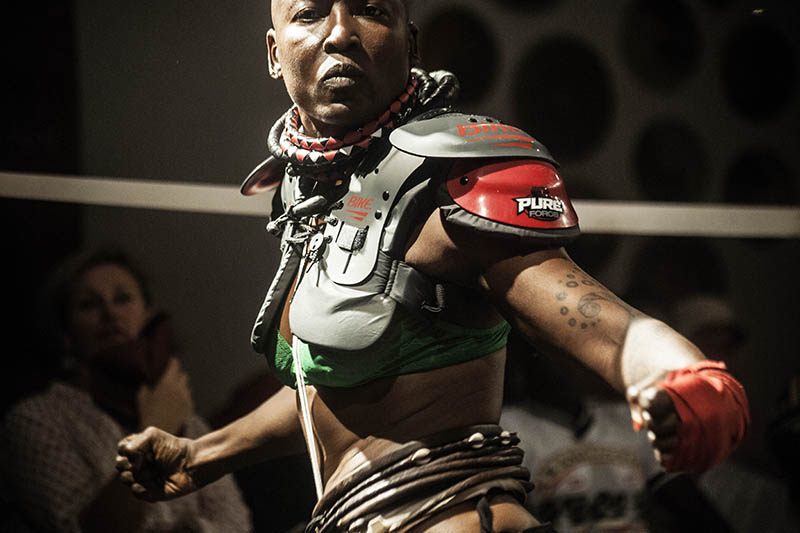
There’s a reason that Nora Chipaumire’s “Portrait of Myself as My Father” earned a spot in University Musical Society’s Renegade series, which highlights cutting edge artists (and works) that take risks.
“Portrait,” an avant-garde dance work conceived, costumed, lit, choreographed, directed and performed (along with Pape Ibrahima Ndiaye, also known as Kaolack, and Shamar Watt) by Chipaumire, is now being presented at Detroit’s Downtown Boxing Gym.
And once audience members enter the performance space – a boxing ring, bordered by red, white, and blue ropes, and surrounded by bleachers on four sides – they immediately confront bright halogen lights, a loud, electronic soundscape, and Chipaumire herself, talking into a boxing microphone that dangles from the building’s rafters.
If you think this doesn’t give you the chance to feel comfortable and settled, you’re right. You won’t. And your heightened alertness will likely be sustained throughout the hour-plus show.
For “Portrait” is all about overwhelming your senses (Philip White’s music ranges from distorted electronica and white noise to pulsing hiphop and drumming, and the room is shrouded in complete darkness, save for the portable halogen worklights, which sometimes shine directly in your line of vision); subverting conventions (like any kind of linear narrative); and collapsing areas of difference, whether it’s time – combining ritualistic African dances with ultra-modern, avant garde movements – or gender. Indeed, Chipaumire, a woman, acts as our guide to black manhood and masculinity while wearing football shoulder pads, a sheer black bra, and low-slung black pants, with a mostly-shaved head.
Ndiaye, meanwhile, is dressed in little more than a pair of red shorts, and he’s the primary subject of Chipaumire’s exploration, charismatically acting out her instructions and observations. Often, her questions slowly build upon each other: “How do you become a man? How do you become a black man? How do you become an African black man?” And both Ndiaye and Chipaumire are connected by cloth tethers that stretch far beyond the boxing ring, as well as to each other, simultaneously suggesting a familial umbilical cord and enslavement.
Tall, lanky Watt acts as more of a one-man stage crew, audience wrangler, and circus ringleader, dressed in a black tailcoat and red track pants, but he plays a larger role within the show as it progresses. During one segment, he wowed the crowd by repeatedly leaping over the boxing rings ropes and onto the floor.
Chipaumire deconstructs black African manhood by breaking it down into gestures, which is to say, specific ways of moving through the world. She states early on that “This is a manifesto about the black African,” and in her artist’s statement in the program, she talks about how personal the piece is. For the piece is inspired by Chipaumire’s experience: she last saw her father when she was five, and he died in 1980. She has since tried to learn more about him, and fill in some of the blanks, but in the end, she can never know him, and she imagines him in a boxing ring, doing battle not only with the forces of the larger world, but within himself.
This leads to an arresting final moment in the show, wherein Chipaumire is seen in the darkness carrying Ndiaye on her back, and Watt asks, “What is this about?” Chipaumire answers that it is about her father, whose carcass she carries with her. It’s a powerful image, and it achieves a fierce intimacy. But I must confess that before this scene, I struggled mightily to fit the show’s pieces together in any kind of cohesive, emotionally impactful way. I’d committed so much energy trying to unlock the show’s mysteries that it ultimately eluded me.
Even so, there are clearly some intriguing, complex ideas driving “Portrait.” Even as Watt repeatedly yells “Champion!” and leads the crowd in applauding Ndiaye, as he goes through the paces of Chipaumire’s sharp demands, you can’t escape the reminder of how often we watch black male bodies perform athletic feats for our pleasure and public consumption.
So some of these thought-provoking, disquieting moments definitely land, but mostly, this “Portrait” inevitably seems blurred.
Jenn McKee is a former staff arts reporter for The Ann Arbor News, where she primarily covered theater and film events, and also wrote general features and occasional articles on books and music.
Portrait of My Father continues Saturday, November 19 at 8:00 pm and Sunday, November 20 at 2:00 pm at the Downtown Boxing Gym in Detroit, 6445 E. Vernor Hwy. Tickets are available here or through the ticket office by calling 734-764-2538. For more information, visit http://ums.org/performance/portrait-of-myself-as-my-father/.
Review: U-M’s 'A Man of No Importance' celebrates theater and love
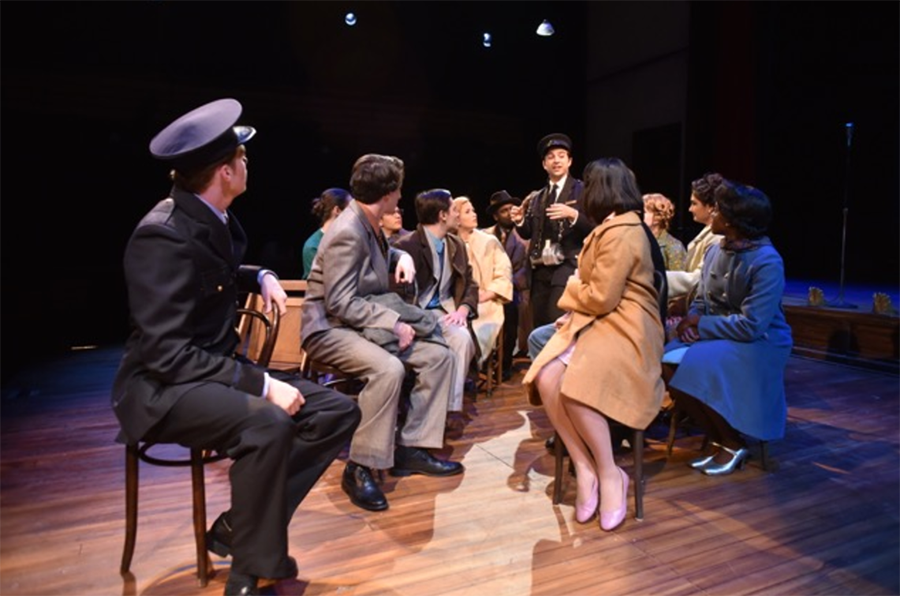
On one level the musical A Man of No Importance is a lovely celebration of community theater and those whose lives become brighter in its spotlight, but in a deeper sense it’s the story of one lonely man’s struggle to find himself and shed light on who he really is.
The University of Michigan School of Music, Theatre and Drama finds the perfect tone for each of these themes in a production that is beautifully performed, capturing the nuances that give this musical its special power.
The musical with book by Terrence McNally, music by Stephen Flaherty and lyrics by Lynn Ahrens is based on a 1994 movie starring Albert Finney and like the film, the musical is set in Dublin, Ireland, circa 1964. It’s a time of change, with musical and cultural influences shaking things up in the British Isles and soon in the world at large. But time moves a bit more slowly in Ireland, where people hold firm to their long held beliefs.
Alfie Byrne works by day as a bus conductor, but his real passion is directing plays. He relies on his friends and neighbors and the folks on the bus to be his star players. He has won some local renown for his production of Oscar Wilde’s The Importance of Being Earnest at St. Imelda’s church hall, but now he wants to stage Wilde’s considerably more controversial Salome.
The flamboyant and sensitive Wilde is Alfie’s hero and a clue to what really bothers Alfie, a homosexual deep in the closet with a growing attraction to his young, golden-haired mate, the bus driver Robbie.
Alfie lives with his loving, dedicated, conservative, nagging sister Lily, who worries about Alfie’s lack of female companionship and about her own sacrifice of happiness to care for her “odd” brother.
All of this could be heavy going, but A Man of No Importance is a funny, sweet and lively portrayal of the love of theater, life in the city and the value of friendship.
Director Vincent J. Cardinal is able to delicately balance the joyous with the morose and make it work. The musical numbers are not big show stoppers but they are well crafted to the needs of the show and are a pleasant mix of up-tempo and gentle. Cardinal and choreographer Aline Mayagoitia give stylish movement even to the rhythm of a bus ride and to a night out in working man’s Dublin. The band under music director Catherine A. Walker gives solid support with a score that uses Irish folk music and instrumentation as measured grace notes.
At the productions center is Barrett Riggins as Alfie Byrne. Riggins gives him a dreamy, distant quality but also shows the warm friendly man who, without realizing it, is a magnet to his friends who find meaning and purpose in the theater he loves. Riggins has the right mix of charm and sadness to make an audience smile and cry and his growing sense of who and what he is develops slowly and delicately. He has several standout musical moments, especially “Man in the Mirror” and the beautiful “Love Who You Love.”
Emilie Kouatchou is a charming, shy and yet strong presence as the girl on the bus who Alfie charms into playing his idealized Salome. She, too, harbors a secret and her performance intelligently foreshadows what is to come. Kouatchou has a fine voice and several good songs especially on the “The Burden of Life” and “Tell Me Why.”
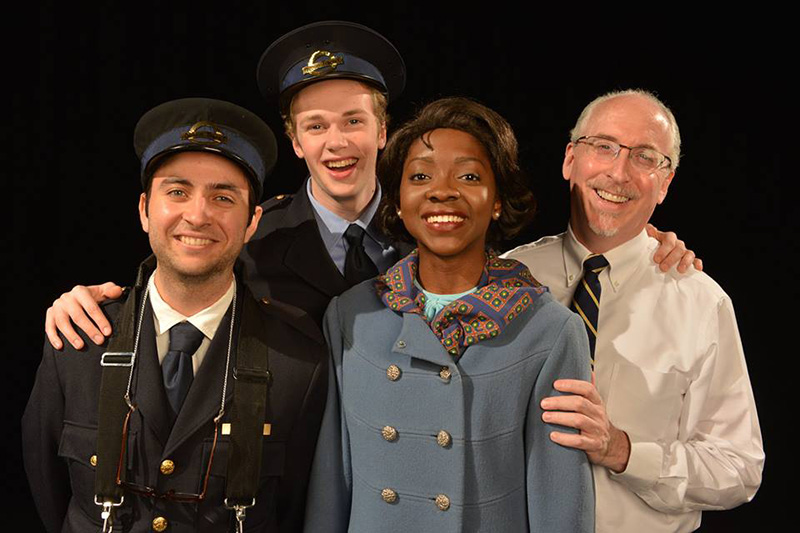
Kat Ward is tough, unrelenting and yet warm and comforting as Alfie’s sister Lily. She won’t stand for any of these modern ideas and Ward plays this side of Lily with fierce determination but matches it with a touching concern for what she sees as her “wayward” brother. She also has a soft spot for the local butcher, and Alfie’s most talented actor, Mr. Carney.
Elliott Styles is excellent as Mr. Carney. He gives strong voice to the theater loving song “Going Up,” a modern take on “There’s No Business Like Show Business.” Mr. Carney loves theater and Alfie’s sister but he is horrified by Wilde’s Salome. In an interesting bit of casting, Styles also plays Alfie’s dream image of Oscar Wilde in all his flamboyant glory.
Robbie, the object of Alfie’s affection, is played with boyish charm by Ben Walker, who leads the cast through a rollicking night out on "The Streets of Dublin" but also shows a sensitive side when he realizes what is happening with his friend.
BJ Myers plays Baldy, another poor soul brought to life by Alfie’s theater. He is a widower who tells Alfie something about love in the bittersweet "The Cuddles Mary Gave." Myers has a fine voice with a unique and effective phrasing.
The play is certainly not sympathetic to the official Catholic church teachings but it makes a clear separation between that and those on the parish level. Sam Hamashima plays a sympathetic, friendly Father Kenny as a sort of balance to the play’s criticism.
The set by Anton Volovsek makes great use of the Miller Theater’s small space in his recreation of a church hall, with a simple stage, a floor that probably doubles as a basketball court, a Sacred Heart of Jesus painting on a wall and heavy sidedoors that provide access points. Spare props fill in for dining rooms and street scenes.
The entire ensemble is excellent, everyone is into their parts completely. Alfie himself couldn’t have dreamed of a better or more dedicated company for his Salome or for a play that shows just how important one man can be to a community.
Hugh Gallagher has written theater and film reviews over a 40-year newspaper career and was most recently managing editor of the Observer & Eccentric Newspapers in suburban Detroit.
A Man of No Importance continues 8 pm Friday, Nov. 18, and Saturday, Nov. 19, and 2 pm Saturday, Nov. 19, and Sunday, Nov. 20, at the Arthur Miller Theatre on the North Campus of the University of Michigan. For ticket information, call (734) 764-2538 or visit online at http://tickets.music.umich.edu.
Fabulous Fiction Firsts #618

“All Americans have something lonely about them. I don't know what the reason might be, except maybe that they're all descended from immigrants.” -Ryū Murakami
Two of the most anticipated debuts this fall take readers deep into the lives of immigrant families.
The Wangs vs. the World * by Jade Chang follows an Chinese-American family as it tumbles from riches to rags. Charles Wang landed in LA as a young man penniless but managed to make a fortune in cosmetics. Now in his fifties, a series of rash business choices and the 2008 financial crisis bankrupted him. Homeless (his Bel-Air mansion foreclosed) and unable to pay tuition for his younger kids, he packs up what he could in the 1950 baby-blue Mercedes that used to belong to his dead first wife, rounds up the kids and a disgruntled second wife Barbra and heads for upstate New York - to daughter Saina's renovated farmhouse.
Unbeknownst to his family, Charles has no intention of settling in the middle of nowhere. His plans is to deposit his family on Saina, and heads to China to reclaim his ancestral lands (and his dignity), lost in the communist takeover. "It turns out that the Wangs can’t function without the trappings of their now-lost lavish lifestyle, a situation that gives the road trip a decidedly wacky bent and infuses the novel with humor. " -Booklist
With each bump on the road, the Wangs might eventually come to see what matters when you think you've lost it all; and what it means to be a family.
Ann Arbor author and a O. Henry Prize winner Derek Palacio's debut The Mortifications * is praised by Peter Ho Davies as "(a) revelatory tale of Cuba and America, of faith and family, of the spirit and the flesh,... a debut remarkable for its wise and scrupulous insight into the human heart. Palacio feelingly reminds us that all immigrants are also exiles, wounded with loss, striving to make a home even as they yearn for the one they’ve left behind.”
During the 1980 traumatic Mariel Boatlift, Soledad Encarnación took twins Isabel and Ulises and fled to the US, leaving behind husband/father Uxbal, a committed revolutionary, for the promise of a better life. Settling in Hartford, Connecticut, far from the Miami Cuban immigrant community, they began a process of growth and transformation.
While Soledad establishes herself as a court stenographer and finds romance with Henri Willems, a Dutch horticulturalist eager to cultivate Cuban tobacco; Isabel, spiritually hungry and desperate for higher purpose, becomes a nun and works with the dying; Ulises, bookish and awkwardly tall, like his father, finds an aptitude working the soil. When Soladad is stricken with breast cancer, she asks Ulises to find Isabel who has disappeared, thus setting the stage of their homecoming where Uxbal awaits.
"Palacio’s writing is deceptively simple and startlingly original, and his characters, raw, almost mythic in scope, hang on long after the last page....Searching, heartbreaking, and achingly beautiful, the novel is as intimate as it is sweeping." -Kirkus Reviews
* = starred review
PowerArt! Profile: David Zinn

David Zinn's art is all over Ann Arbor, but you may not know it.
In addition to two PowerArt boxes recently installed at Main and William (PenPals) and at Liberty and First Ave (Selfie Monster) as part of the PowerArt Project, the Ann Arbor native is also responsible for the witty trompe l'oeil rendition of Singin' in the Rain which can be found on Fifth Avenue across from the Ann Arbor Public Library's downtown branch. And recently he was one of the artists represented at Ann Arbor Art Center's Pop-X Festival.

David Zinn is best known, though, as a master of comic ephemerality. He creates improvised temporary street art entirely from chalk, charcoal and found objects. His works feature fanciful creatures that pop into and out of our dimension, visitors from his wild imagination. He likes "walking around seeing places where art wants to be and putting it there."
Zinn's improbable career as a street artist began about 14 years ago as an escape from the tedium of his job as a graphic designer:
"The first day I did this, I had a really important job that I had to finish in two days, and I should have been sitting in front of my computer doing this very important job and doing all the very important things I was supposed to do. It was completely childish and irresponsible to go outside, but it was a beautiful day. The sun was out, it was 76 degrees and that does not happen here every day. And it made sitting in front of a computer seem kind of irrational."
Zinn's temporary artworks are relentlessly cheerful and entertaining. Sluggo, an amorphous blob with eyes on stalks and Philomena, a pig with wings, make frequent appearances in his temporary artworks along with a wide array of tiny monsters, valiant mice, elves and some creatures that are frankly, impossible to categorize. They bubble up out of his subconscious and dissipate just as quickly.
Zinn spends quite a bit of creative energy in subverting the status of his works as permanent art objects. He is not interested in showing his work in galleries, or in treating them as objects to venerate as high art. He values spontaneity and surprise above all.
"If it isn't going to be destroyed there's a lot I should be worrying about right now-- whether it’s good enough, whether it's serious enough. II feel bad for painters who paint conventionally on canvas, because when you finish a canvas, no matter whether you sell it, give it away or keep it in your attic, these are all things that you now have to do...but if you can't take it home, or somebody's going to eat it, or it's going to get rained on anyway, then you're free to just do what's going to make you happy now. And if you like it you can take a picture."
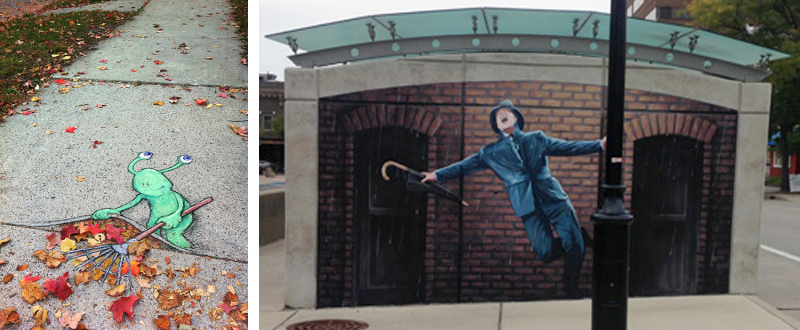
And that's exactly what David Zinn has done. He recently published a thoroughly entertaining book of his favorite temporary chalk artworks entitled Temporary Preserves. It includes not only pictures of his outdoor creations, but also photos of many of his smaller efforts made on the tables of restaurants in Ann Arbor during Michigan's cold winter months.
"The rationale for the book is that I went out on the sidewalk to get away from the computer and it was an increasingly sad irony to observe that now what I did to get away from the computer, people are sitting at the computer to look at."
K.A. Letts is an artist and art blogger. She has shown her work regionally and nationally and in 2015 won the Toledo Federation of Art Societies Purchase Award while participating in the TAAE95 Exhibit at the Toledo Museum of Art. You can find more of her work at RustbeltArts.com.
Take a walk and see the PowerArt! boxes up close and personal; a map of PowerArt! box locations is available to download. PowerArt is a partnership between the Ann Arbor Downtown Development Authority (AADDA) and the Ann Arbor Public Art Commission (AAPAC), The Arts Alliance is managing the selection and installation of artwork by local artists on power boxes throughout downtown Ann Arbor. You'll find more info about the project at the Arts Alliance website.
Preview: Ron Brooks Trio+ Remembers CJQ & More
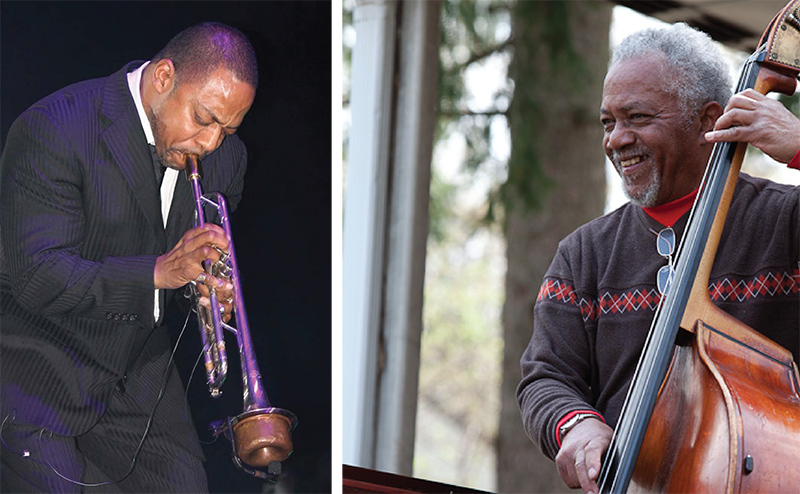
Jazz bassist Ron Brooks has held many roles as bandleader and sideman. Among them are working with famed pianists Bob James and Stanley Cowell and serving as a founding member of the legendary Contemporary Jazz Quartet/Quintet (CJQ), the Latin jazz band Mixed Bag, and of course many versions of the Ron Brooks Trio. As the owner and operator of the late lamented Bird of Paradise nightclub, Brooks performed nearly every night in Ann Arbor for over four decades.
Brooks’ performance schedule since the Bird closed its doors in 2004 has been reduced to select gigs. He spends his daytime hours as a mediator for a Jackson, MI dispute resolution center - as he has most of his adult life. But jazz fans who know him as "The Mayor" will have an opportunity to hear both the Brooks trio and a recreation of CJQ in a single performance at the Kerrytown Concert House. This is a repeat of an historic show at the recent Detroit Jazz Festival (DJF) in tribute to CJQ and DJF’s founding father, pianist/composer Kenn Cox. It will also feature the music of Brooks’ partner, Eddie Russ, along with Larry Nozero in Mixed Bag.
Beyond CJQ, Brooks is the founder and President Emeritus of the Southeastern Michigan Jazz Association. He's worked with arts and philanthropic organizations including The Jazz Alliance of Michigan (JAM). He's been one of the most prominent African-American business persons in Washtenaw County. And he's a prolific performer in his own right, backing many major jazz performers coming through town.
Some of those artists have been Tommy Flanagan, Frank Morgan, Diana Krall, David “Fathead” Newman, Shirley Horn, Kenny Burrell, Mark Murphy, Betty Carter, Sonny Stitt; and countless others, including the greater contingent of Detroit jazz players. Brooks also has the distinction of playing with the legendary Eric Dolphy prior to his untimely death in the early 1960s.
The 2016 Brooks 3 + 2 combo will include saxophonist/flutist Vincent Bowens and trumpeter Rayse Biggs, two of the more prominent Detroit based musicians. With the passing of Leon Henderson (brother of the renowned saxophonist Joe Henderson) and the iconic trumpeter Charles Moore from the CJQ, Bowens and Biggs are two of Detroit’s more capable interpreters of contemporary regional jazz.
Kenn Cox's parts will be taken by pianist Gary Schunk, while drummer Djallo Djakate Kieta has the unenviable duty of taking over for two CJQ drummers who played side-by-side - the late Bud Spangler and West Coast transplant Danny Spencer. They will play material from the recently reissued Blue Note album Introducing Kenn Cox And The Contemporary Jazz Quintet, the landmark recording that stands alongside the Miles Davis epic Bitches Brew as one of the pivotal bridge recordings between the modern acoustic mainstream and jazz rock fusion movements.
In a recent interview, Brooks remembers all the places he played over six decades - most of which are long gone. They include Mackinac Jack's; the original Canterbury House, when it was on Maynard Street; the Loma Linda; the Del Rio; The Towne Bar; Mr. Flood's Party; the Old Town Tavern; the Golden Falcon; Schwaben Hall; and the People's Ballroom. He also recalls the 1972 Ann Arbor Blues & Jazz Festival at Otis Spann Memorial field next to Huron High School where he played with the CJQ+.
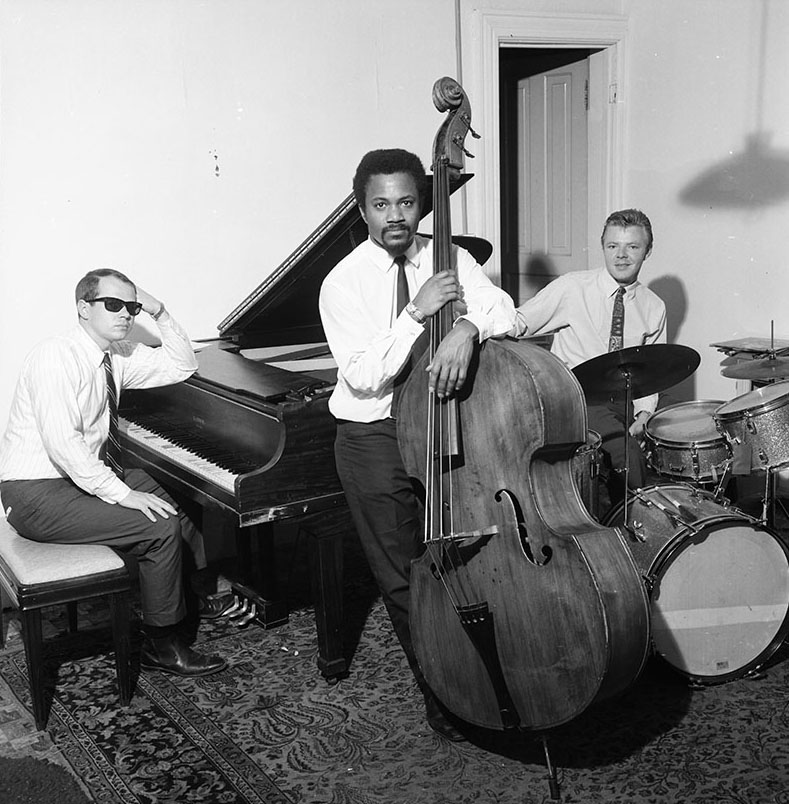
Brooks also played The Earle; the top floor Sandalwood Lounge with Mixed Bag every Sunday night; the lobby of the Ann Arbor Inn; of course The Bird; as well as more recently, The Raven's Club and Bigalora on Washtenaw Avenue.
Brooks recalls the origin of "The Mayor" moniker, bestowed upon him by the late Marcus Belgrave. “When there was the political challenge or coup of getting a liquor license,” Brooks reminisces, “during a time when they were based on the repopulation of Ann Arbor and only seven new licenses came up, I was one of several people to apply. Larry Hunter was helpful on the City Council - he was a good guy - and I was the last to get a license as there were no other minorities who had them. Marcus made a comment like, ‘Well, you're like The Mayor,’ and it stuck."
Brooks addressed why now is the right time to bring the music of Cox and Russ to the forefront. “Stanley Cowell from Toledo and Danny Spencer were my roommates,” said Brooks, “Pianists Mike Lang or Dr. Tim Tomke, drummers Bob ‘Cleve’ Pozar and Bob Elliott were there in the early days, too. We were trying to find places to demonstrate what the music was and how valuable it would be in the community. Bob James left Ann Arbor after we won the Notre Dame Intercollegiate Jazz Festival, followed by the forming of CJQ.”
Fast forwarding some fifty years later, Brooks added, “I was approached by the Detroit Jazz Festival as a surviving member of CJQ, so we put it together and pulled out a few of Kenny's old tunes and I thought it was a good idea to keep the band going if I could.
“It’s about time. The charts are sprinkled all around - [longtime RB3 drummer] George Davidson had some, [Mixed Bag percussionist] Dave Koether had some from Eddie, and the music was accessible. Barbara Cox [Kenny's widow] was very cooperative. Vincent and Rayse were aware and into it, so I was encouraged to commemorate Kenny's and Eddie's music.
“The experiences I've had were wonderful for me,” concluded Brooks. “I owe so much to music - my life and my success - to the advent of being around and exposed to these musicians who helped in my personal growth. I miss the people the most, but the quality of the music especially at The Bird was so high. What flashes in my mind was the night we had Dizzy Gillespie in town and there were two or three hundred people off the street looking through the window at his trumpet bent up in the air. That vision comes back to me often."
Michael G. Nastos is known as a veteran radio broadcaster, local, national and international music journalist, and event promoter/producer. He is a former music director and current super sub on 88.3 WCBN-FM Ann Arbor, founding member of SEMJA, the Southeastern Michigan Jazz Association, Board of Directors member of the Michigan Jazz Festival, votes in the annual Detroit Music Awards and Down Beat Magazine, NPR Music and El Intruso Critics Polls, and writes monthly for Hot House Magazine in New York City.
The Ron Brooks 3 + 2 play The Kerrytown Concert House, 415 N. Fourth Avenue this Friday, November 18 at 8 pm. For more information call (734) 769-2999 or visit http://kerrytownconcerthouse.com. They also appear at Schoolcraft College in Livonia for a SEMJA benefit at 3 pm on Sunday, November 20.


































